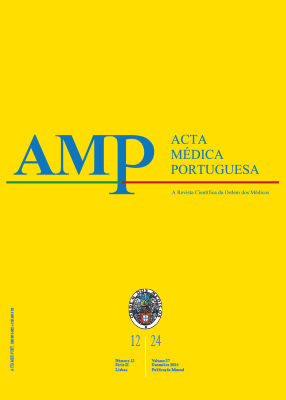Diagnostic, Therapeutic and Monitoring Approach in Suspected Neurosyphilis: Proposal for a Clinical Guideline
DOI:
https://doi.org/10.20344/amp.21847Keywords:
Neurosyphilis/diagnosis, Neurosyphilis/treatment, Syphilis SerodiagnosisAbstract
This clinical guideline was designed to serve as a hospital guide in the diagnostic, therapeutic, and monitoring approach to neurosyphilis, considering whether there is positivity or not for the human immunodeficiency virus. Syphilis is a sexually transmitted notifiable disease, known as the great imitator. In around 30% of cases of untreated disease, there is a persistent central nervous system infection. Neurosyphilis is a severe and progressive form of syphilis, which can occur at any stage of the disease, with frequent delays in diagnosis and treatment. It is classified as early neurosyphilis (syphilitic meningitis, meningovascular neurosyphilis, or syphilitic gummas) and late neurosyphilis (syphilitic gummas, general paresis, or tabes dorsalis). The importance of lumbar puncture lies not only in its diagnostic value but also in evaluating the effectiveness of treatment. The treatment of this disease in all stages consists of parenteral penicillin. With this guideline, our aim is to facilitate clinical decision-making in cases of suspected neurosyphilis through a systematized, individualized, and multidisciplinary approach.
Downloads
References
Chow F. Neurosyphilis. Contin Lifelong Learn Neurol. 2021;27:1018-39.
Denman J, Hodson J, Manavi K. Infection risk in sexual contacts of syphilis: a systematic review and meta-analysis. J Infect. 2022;84:760-9.
Stoltey JE, Cohen SE. Syphilis transmission: a review of the current evidence. Sex Health. 2015;12:103-9.
Workowski KA, Bolan GA. Sexually transmitted diseases treatment guidelines, 2015. MMWR Recomm Reports. 2015;64:1-137.
European Centre for Disease Prevention and Control. Syphilis - annual epidemiological report for 2021. [consultado 2023 dez 26]. Disponível em: https://www.ecdc.europa.eu/sites/default/files/documents/syphilisannual-
epidemiological-report-2021.pdf.
Marra CM. Neurosyphilis. Continuum. 2015;21:1714-28.
Hamill MM, Ghanem KG, Tuddenham S. State-of-the-art review: neurosyphilis. Clin Infect Dis. 2024;78:e57-68.
Ropper AH. Neurosyphilis. N Engl J Med. 2019;381:1358-63.
Klein M, Angstwurm K, Esser S, Hahn K, Maschke M, Scheithauer S, et al. German guidelines on the diagnosis and treatment of neurosyphilis. Neurol Res Pract. 2020;2:33.
Maury I, Alves M, Fonseca T. Neurosyphilis prevalence at a Portuguese stroke unit care. Aging Clin Exp Res. 2019;31.
Lautenschlager S. Diagnosis of syphilis: clinical and laboratory problems. J Dtsch Dermatol Ges. 2006;4:1058-75.
Bibbins-Domingo K, Grossman DC, Curry SJ, Davidson KW, Epling Jr JW, Garcia FA, et al. Screening for syphilis infection in nonpregnant adults and adolescents: US Preventive Services Task Force Recommendation Statement. JAMA. 2016;315:2321-7.
Centers for Disease Control and Prevention. Sexually transmitted infections treatment guidelines. 2021. [consultado 2024 jan 01]. Disponível em https://www.cdc.gov/std/treatment-guidelines/syphilis.htm.
Janier M, Unemo M, Dupin N, Tiplica GS, Potočnik M, Patel R. 2020 European guideline on the management of syphilis. J Eur Acad Dermatol Venereol. 2021;35:574-88.
Boog GH, Lopes JV, Mahler JV, Solti M, Kawahara LT, Teng AK, et al. Diagnostic tools for neurosyphilis: a systematic review. BMC Infect Dis. 2021;21:568.
Gao ZX, Gou Y, Liu XQ, Peng LW. Advances in laboratory diagnostic methods for cerebrospinal fluid testing for neurosyphilis. Front Public Health. 2022;10:1030480.
Sytsma TT, Theel ES, Temesgan Z, Toledano M. Assessing utilization of the cerebrospinal fluid venereal disease research laboratory test for diagnosis of neurosyphilis: a cohort study. J Gen Intern Med. 2021;36:77-83.
Singh AE. Ocular and neurosyphilis: epidemiology and approach to management. Curr Opin Infect Dis. 2020;33:66-72.
Workowski KA, Bachmann LH, Chan PA, Johnston CM, Muzny CA, Park I, et al. Sexually transmitted infections treatment guidelines, 2021. MMWR Recomm Rep. 2021;70;2021.
Kingston M, French P, Higgins S, McQuillan O, Sukthankar A, Stott C, et al. UK national guidelines on the management of syphilis 2015. Int J STD AIDS. 2016;27:421-46.
Tuddenham S, Ghanem KG. Neurosyphilis: knowledge gaps and controversies. Sex Transm Dis. 2018;45:147.
Hook EW 3rd. Syphilis. Lancet. 2017;389:1550-7.
New York City Department of Health and Mental Hygiene Bureau of Sexually Transmitted Infections; New York City STD Prevention Training Center. The diagnosis, management and prevention of syphilis: an update and review. New York: NYC Health; 2019. [consultado 2024 jan 21]. Disponível em: https://www.nycptc.org/x/Syphilis_Monograph_2019_NYC_PTC_NYC_DOHMH.pdf.
Kenyon C, Herrmann B, Hughes G, de Vries HJ. Management of asymptomatic sexually transmitted infections in Europe: towards a differentiated, evidence-based approach. Lancet Reg Health Eur. 2023;34:100743.
Downloads
Published
How to Cite
Issue
Section
License
Copyright (c) 2024 Acta Médica Portuguesa

This work is licensed under a Creative Commons Attribution-NonCommercial 4.0 International License.
All the articles published in the AMP are open access and comply with the requirements of funding agencies or academic institutions. The AMP is governed by the terms of the Creative Commons ‘Attribution – Non-Commercial Use - (CC-BY-NC)’ license, regarding the use by third parties.
It is the author’s responsibility to obtain approval for the reproduction of figures, tables, etc. from other publications.
Upon acceptance of an article for publication, the authors will be asked to complete the ICMJE “Copyright Liability and Copyright Sharing Statement “(http://www.actamedicaportuguesa.com/info/AMP-NormasPublicacao.pdf) and the “Declaration of Potential Conflicts of Interest” (http:// www.icmje.org/conflicts-of-interest). An e-mail will be sent to the corresponding author to acknowledge receipt of the manuscript.
After publication, the authors are authorised to make their articles available in repositories of their institutions of origin, as long as they always mention where they were published and according to the Creative Commons license.









